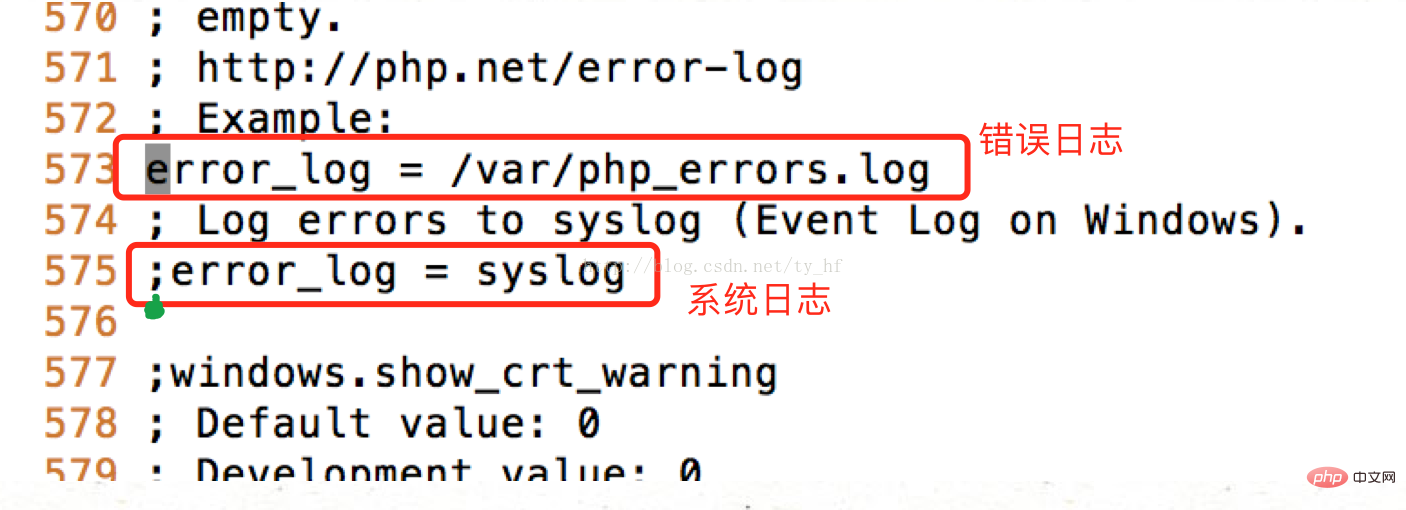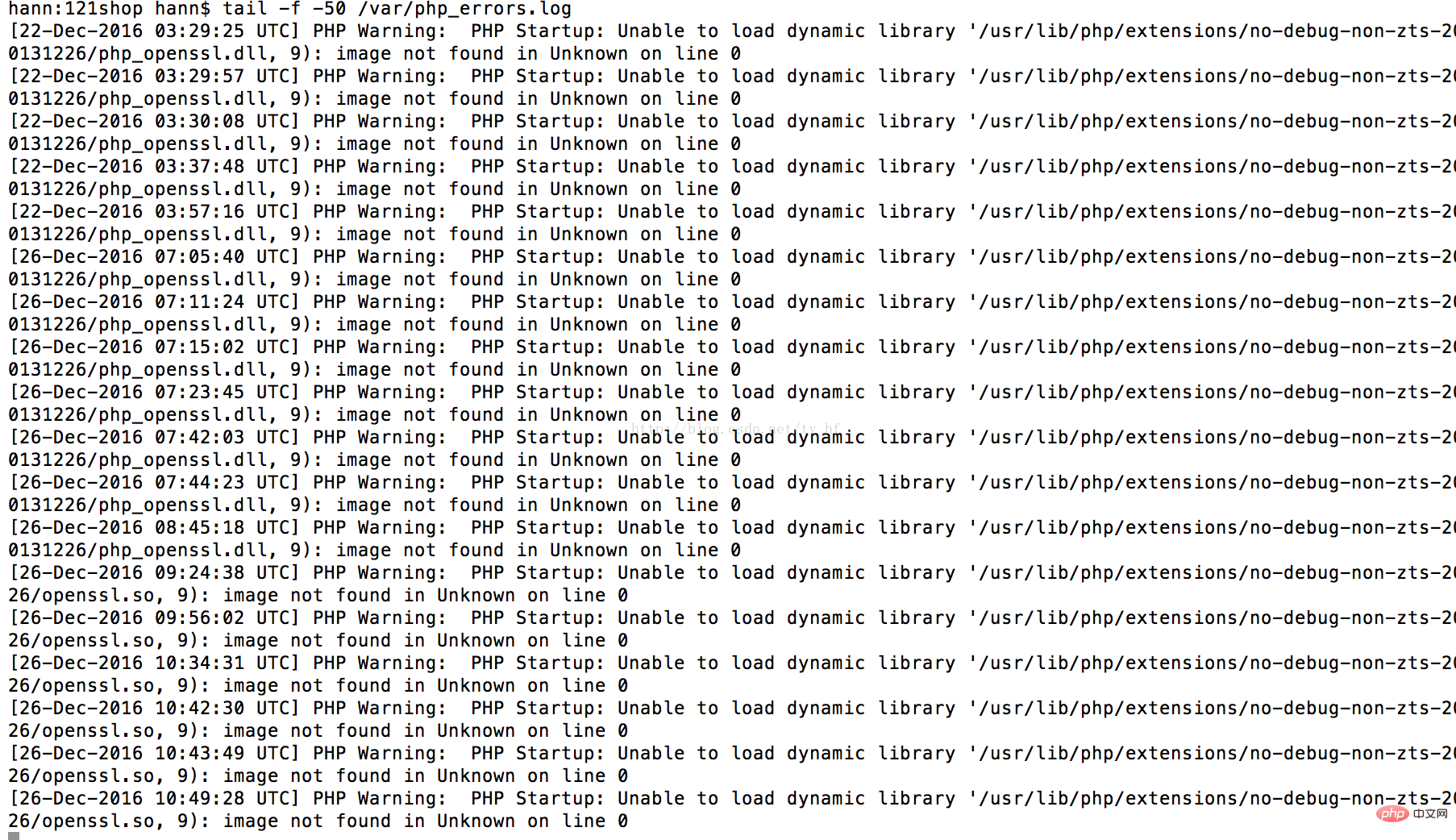How to read php error log
Viewing method: 1. Configure the "php.ini" file; 2. Use the phpinfo() command to view the error log address; 3. Use the "vi /etc/php.ini" command to view the log location; 4. Use "tail -f -50 /var/php_errors.log" to view the log.

The operating environment of this tutorial: windows7 system, PHP7.1 version, DELL G3 computer
For our PHP developers, on In the production environment, be sure to turn off related debug, display_errors error prompts, etc. Who can’t help but make a mistake? This can prevent non-fatal errors from leaking information such as project paths and databases. So the question is, how do we check PHP and other related errors in production? In fact, you can check it in the error log (error.log or send it directly to syslog).
The following is a brief description of how to configure and view logs.
1. Related configuration
You need to modify the configuration instructions in php.ini as follows:
1 2 3 4 5 |
|
PHP’s configuration file is as above After the settings are completed, restart the web server. In this way, when executing any PHP script file, all error reports generated will not be displayed in the browser, but will be recorded in the error log /usr/local/error.log that you specify. .
In addition, not only can all errors that meet the rules defined in error_reporting be recorded, but also the error_log() function in PHP can be used to send a user-defined error message.
2. Check the storage address
1. Check the error log storage address through php.ini
1 |
|
Or output it in a php file phpinfo();View the error log storage location
2. View the log storage location
1 |
|

3. View the log:
1 |
|

In addition to general error output, PHP also allows s## to the system Send customized messages in #yslog. Although customized messages can also be sent to syslog through the error_log() function introduced earlier, PHP provides 4 dedicated functions for this feature that need to be used together. It will not be introduced here.
The above is the detailed content of How to read php error log. For more information, please follow other related articles on the PHP Chinese website!

Hot AI Tools

Undresser.AI Undress
AI-powered app for creating realistic nude photos

AI Clothes Remover
Online AI tool for removing clothes from photos.

Undress AI Tool
Undress images for free

Clothoff.io
AI clothes remover

AI Hentai Generator
Generate AI Hentai for free.

Hot Article

Hot Tools

Notepad++7.3.1
Easy-to-use and free code editor

SublimeText3 Chinese version
Chinese version, very easy to use

Zend Studio 13.0.1
Powerful PHP integrated development environment

Dreamweaver CS6
Visual web development tools

SublimeText3 Mac version
God-level code editing software (SublimeText3)

Hot Topics
 CakePHP Project Configuration
Sep 10, 2024 pm 05:25 PM
CakePHP Project Configuration
Sep 10, 2024 pm 05:25 PM
In this chapter, we will understand the Environment Variables, General Configuration, Database Configuration and Email Configuration in CakePHP.
 PHP 8.4 Installation and Upgrade guide for Ubuntu and Debian
Dec 24, 2024 pm 04:42 PM
PHP 8.4 Installation and Upgrade guide for Ubuntu and Debian
Dec 24, 2024 pm 04:42 PM
PHP 8.4 brings several new features, security improvements, and performance improvements with healthy amounts of feature deprecations and removals. This guide explains how to install PHP 8.4 or upgrade to PHP 8.4 on Ubuntu, Debian, or their derivati
 CakePHP Date and Time
Sep 10, 2024 pm 05:27 PM
CakePHP Date and Time
Sep 10, 2024 pm 05:27 PM
To work with date and time in cakephp4, we are going to make use of the available FrozenTime class.
 CakePHP File upload
Sep 10, 2024 pm 05:27 PM
CakePHP File upload
Sep 10, 2024 pm 05:27 PM
To work on file upload we are going to use the form helper. Here, is an example for file upload.
 CakePHP Routing
Sep 10, 2024 pm 05:25 PM
CakePHP Routing
Sep 10, 2024 pm 05:25 PM
In this chapter, we are going to learn the following topics related to routing ?
 Discuss CakePHP
Sep 10, 2024 pm 05:28 PM
Discuss CakePHP
Sep 10, 2024 pm 05:28 PM
CakePHP is an open-source framework for PHP. It is intended to make developing, deploying and maintaining applications much easier. CakePHP is based on a MVC-like architecture that is both powerful and easy to grasp. Models, Views, and Controllers gu
 How To Set Up Visual Studio Code (VS Code) for PHP Development
Dec 20, 2024 am 11:31 AM
How To Set Up Visual Studio Code (VS Code) for PHP Development
Dec 20, 2024 am 11:31 AM
Visual Studio Code, also known as VS Code, is a free source code editor — or integrated development environment (IDE) — available for all major operating systems. With a large collection of extensions for many programming languages, VS Code can be c
 CakePHP Creating Validators
Sep 10, 2024 pm 05:26 PM
CakePHP Creating Validators
Sep 10, 2024 pm 05:26 PM
Validator can be created by adding the following two lines in the controller.






